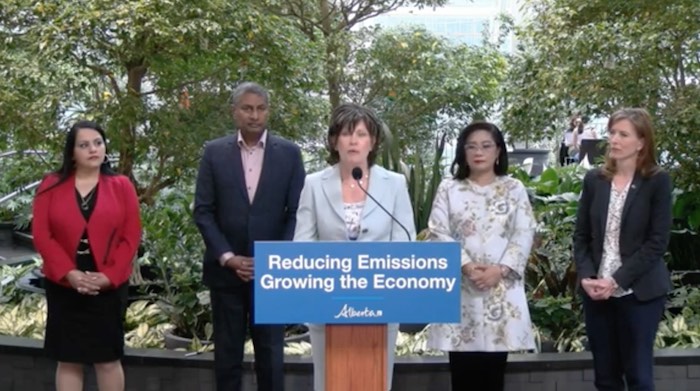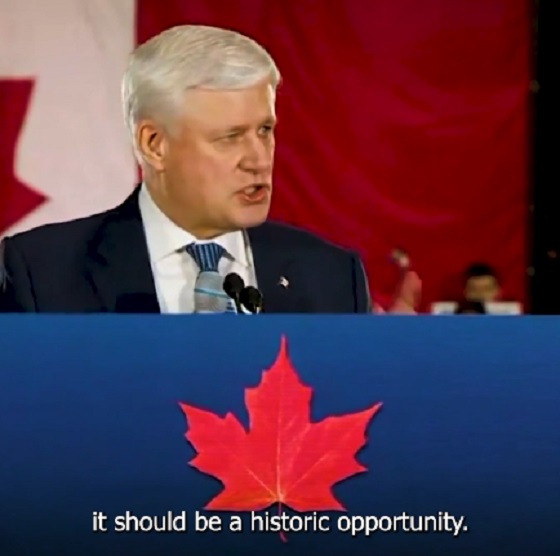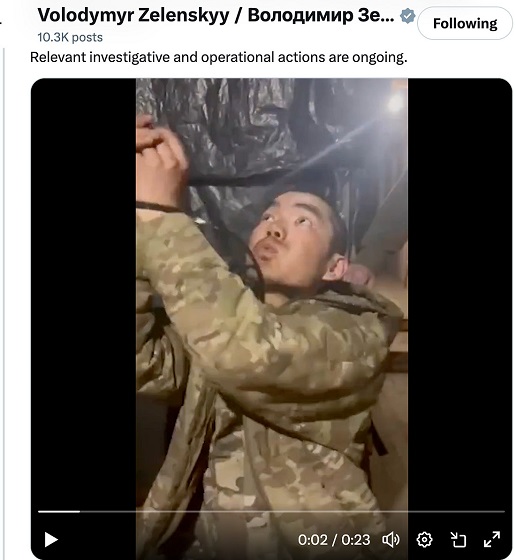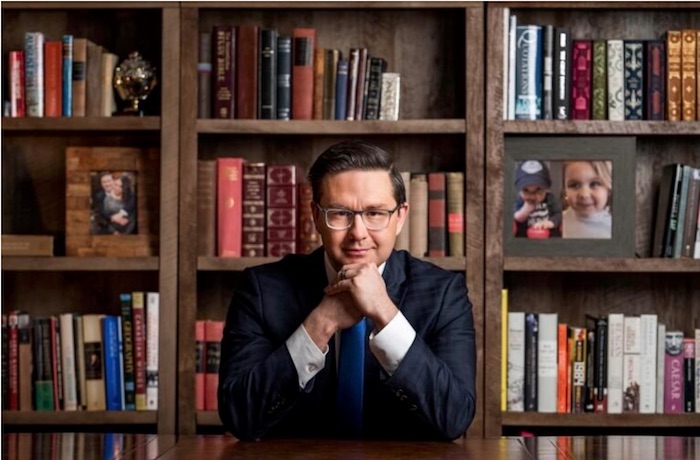Alberta
Province will balance the economy and the environment – Emissions Reduction and Energy Development Plan

Balancing the economy and the environment
Alberta’s new Emissions Reduction and Energy Development (ERED) Plan charts Alberta’s course for cutting emissions, attracting investment and growing the economy.
Albertans have been stewards of one of Canada’s largest economic engines, the oil and gas sector. For decades, Albertans have stepped up to deliver responsible, ethically produced energy, helping mitigate global energy crises and leading in technology innovation to reduce emissions.
The ERED Plan is Alberta’s path forward to net-zero aspirations by 2050 while maintaining affordable, reliable and secure energy for Albertans. The plan affirms that responsibly produced oil and gas will continue to be a fundamental part of the global energy mix in the coming decades while sending a clear signal to the world that Alberta is the place to invest.
“Our made-in-Alberta plan to reduce emissions while growing the economy is a plan that works for Albertans. This could never be a one-size-fits-all model passed on by the federal government. I’m so proud of the work that has been done to bring this forward. Alberta can, and will, be a part of the solution to safeguard North American and global energy security. We can make real progress on environmental protection without sacrificing Alberta’s and Canada’s economic engine.”
Cutting emissions should not make life harder and more expensive. Actions in the ERED Plan like modernizing the electricity system, integrating new technology and supporting natural gas-fired generation will help keep energy reliable, safe and affordable for Albertans.
In February, Premier Danielle Smith sent a letter to Prime Minister Justin Trudeau, informing the federal government that a made-in-Alberta plan was on the way. Alberta’s government is calling on the federal government to stop setting unrealistic, unachievable targets, to stay in their lane and work with the provinces without interfering in provincial jurisdiction. Families need to keep the lights on, buy groceries and have enough gas in their car to get their kids to soccer practice without carrying the burden of expensive government climate policies.
Former premier Ralph Klein took the first step by putting out the first such plan in 1998. Since then, decades of hard work from the men and women who make their living in Alberta’s industries have led to today. The plan Alberta’s government is unveiling salutes the work done by Albertans over decades, culminating in a significant focus over the last four years, and charts the province’s next steps. More work is yet to be done.
“Alberta’s plan forward to reduce emissions while growing economic activity sets a course of success for our province. The conversation about emissions reduction must include energy security, affordability and reliability. This plan does exactly that.”
Alberta’s ERED Plan outlines investment and partnership opportunities, including ways to better support Alberta’s skilled workforce, strengthen relationships with Indigenous organizations and communities, and collaborate with industry. By driving emissions reductions in all sectors through clean technology and innovative solutions, Alberta’s plan protects and diversifies jobs and keeps money in the pockets of hard-working Albertans.
“Alberta will make an outsized contribution to Canada and the rest of the world by developing low-cost technologies towards successful decarbonization. Given Alberta’s ingenuity and energy expertise, it is in the best position to support Canada’s aim to achieve net-zero emissions in 2050.”
“Alberta has demonstrated tremendous leadership in economic reconciliation for Indigenous Peoples by creating opportunities for Indigenous communities to participate in projects that will drive tangible economic benefits and prosperity for generations to come.”
The ERED Plan outlines actions and opportunities across Alberta’s environment and economy, from oil and gas to agriculture and waste management. A summary of actions is available on the ERED Plan website.
As part of Alberta’s work to address the rising cost of living due to inflation, the ERED Plan includes a commitment to explore building codes, labelling and building benchmarking, balancing informed consumer choice with property right considerations, and exploring and growing innovation and technology for homes like new building materials and heat pumps.
“The Pathways Alliance is encouraged by the Government of Alberta’s plan to reduce emissions and achieve net zero while ensuring industry can compete globally, attract investment and continue to provide economic growth and prosperity for Albertans and Canadians.”
“Alberta’s Emissions Reduction and Energy Development Plan presents evidence that Alberta does not require overlapping federal regulation to do what is necessary to meet net zero by 2050 goals. The plan’s net zero by 2050 aspiration is the statement that investors and analysts have been looking for as the overarching signal of commitment to emissions reductions action.”
Quick facts
- Alberta was the first jurisdiction in Canada to establish a climate plan in 1998.
- Alberta was the first jurisdiction in North America to introduce an industrial carbon price and emissions trading system in 2007.
- Alberta was the first government in Canada to set a methane emissions reduction target for the oil and gas sector and is on track to meet and exceed its 2025 methane emissions reduction goal.
- Alberta is expected to transition from coal-fired electricity in 2023, seven years ahead of provincial and federal targets.
- The Technology Innovation and Emissions Reduction (TIER) Regulation, Alberta’s industrial carbon pricing system, is at the core of emissions management in Alberta.
- From 2009 to 2021, $2.5 billion from industrial carbon pricing funds were invested in programs that support emissions reductions and climate resiliency.
- Alberta is recognized as a leader in developing carbon capture, utilization and storage (CCUS) technology, committing more than $1.8 billion to support CCUS projects to date.
Alberta
Alberta takes big step towards shorter wait times and higher quality health care

From the Fraser Institute
On Monday, the Smith government announced that beginning next year it will change the way it funds surgeries in Alberta. This is a big step towards unlocking the ability of Alberta’s health-care system to provide more, better and faster services for the same or possibly fewer dollars.
To understand the significance of this change, you must understand the consequences of the current (and outdated) approach.
Currently, the Alberta government pays a lump sum of money to hospitals each year. Consequently, hospitals perceive patients as a drain on their budgets. From the hospital’s perspective, there’s little financial incentive to serve more patients, operate more efficiently and provide superior quality services.
Consider what would happen if your local grocery store received a giant bag of money each year to feed people. The number of items would quickly decline to whatever was most convenient for the store to provide. (Have a favourite cereal? Too bad.) Store hours would become less convenient for customers, alongside a general decline in overall service. This type of grocery store, like an Alberta hospital, is actually financially better off (that is, it saves money) if you go elsewhere.
The Smith government plans to flip this entire system on its head, to the benefit of patients and taxpayers. Instead of handing out bags of money each year to providers, the new system—known as “activity-based funding”—will pay health-care providers for each patient they treat, based on the patient’s particular condition and important factors that may add complexity or cost to their care.
This turns patients from a drain on budgets into a source of additional revenue. The result, as has been demonstrated in other universal health-care systems worldwide, is more services delivered using existing health-care infrastructure, lower wait times, improved quality of care, improved access to medical technologies, and less waste.
In other words, Albertans will receive far better value from their health-care system, which is currently among the most expensive in the world. And relief can’t come soon enough—for example, last year in Alberta the median wait time for orthopedic surgeries including hip and knee replacements was 66.8 weeks.
The naysayers argue this approach will undermine the province’s universal system and hurt patients. But by allowing a spectrum of providers to compete for the delivery of quality care, Alberta will follow the lead of other more successful universal health-care systems in countries such as Australia, Germany, the Netherlands and Switzerland and create greater accountability for hospitals and other health-care providers. Taxpayers will get a much better picture of what they’re paying for and how much they pay.
Again, Alberta is not exploring an untested policy. Almost every other developed country with universal health care uses some form of “activity-based funding” for hospital and surgical care. And remember, we already spend more on health care than our counterparts in nearly all of these countries yet endure longer wait times and poorer access to services generally, in part because of how we pay for surgical care.
While the devil is always in the details, and while it’s still possible for the Alberta government to get this wrong, Monday’s announcement is a big step in the right direction. A funding model that puts patients first will get Albertans more of the high-quality health care they already pay for in a timelier fashion. And provide to other provinces an example of bold health-care reform.
Alberta
Alberta’s embrace of activity-based funding is great news for patients

 From the Montreal Economic Institute
From the Montreal Economic Institute
Alberta’s move to fund acute care services through activity-based funding follows best practices internationally, points out an MEI researcher following an announcement made by Premier Danielle Smith earlier today.
“For too long, the way hospitals were funded in Alberta incentivized treating fewer patients, contributing to our long wait times,” explains Krystle Wittevrongel, director of research at the MEI. “International experience has shown that, with the proper funding models in place, health systems become more efficient to the benefit of patients.”
Currently, Alberta’s hospitals are financed under a system called “global budgeting.” This involves allocating a pre-set amount of funding to pay for a specific number of services based on previous years’ budgets.
Under the government’s newly proposed funding system, hospitals receive a fixed payment for each treatment delivered.
An Economic Note published by the MEI last year showed that Quebec’s gradual adoption of activity-based funding led to higher productivity and lower costs in the province’s health system.
Notably, the province observed that the per-procedure cost of MRIs fell by four per cent as the number of procedures performed increased by 22 per cent.
In the radiology and oncology sector, it observed productivity increases of 26 per cent while procedure costs decreased by seven per cent.
“Being able to perform more surgeries, at lower costs, and within shorter timelines is exactly what Alberta’s patients need, and Premier Smith understands that,” continued Mrs. Wittevrongel. “Today’s announcement is a good first step, and we look forward to seeing a successful roll-out once appropriate funding levels per procedure are set.”
The governments expects to roll-out this new funding model for select procedures starting in 2026.
* * *
The MEI is an independent public policy think tank with offices in Montreal, Ottawa, and Calgary. Through its publications, media appearances, and advisory services to policymakers, the MEI stimulates public policy debate and reforms based on sound economics and entrepreneurship.
-

 2025 Federal Election2 days ago
2025 Federal Election2 days agoHarper Endorses Poilievre at Historic Edmonton Rally: “This Crisis Was Made in Canada”
-

 2025 Federal Election2 days ago
2025 Federal Election2 days agoMark Carney’s radical left-wing, globalist record proves he is Justin Trudeau 2.0
-

 conflict2 days ago
conflict2 days agoZelensky Alleges Chinese Nationals Fighting for Russia, Calls for Global Response
-

 2025 Federal Election2 days ago
2025 Federal Election2 days agoAn In-Depth Campaign Trail “Interview” With Pierre Poilievre
-

 Business2 days ago
Business2 days agoTrump’s tariff plan replaces free trade with balanced trade. Globalists hate that.
-

 2025 Federal Election17 hours ago
2025 Federal Election17 hours agoConservative Party urges investigation into Carney plan to spend $1 billion on heat pumps
-

 2025 Federal Election2 days ago
2025 Federal Election2 days agoDon’t double-down on net zero again
-

 Censorship Industrial Complex2 days ago
Censorship Industrial Complex2 days agoScott Atlas: COVID lockdowns, censorship have left a ‘permanent black mark on America’





